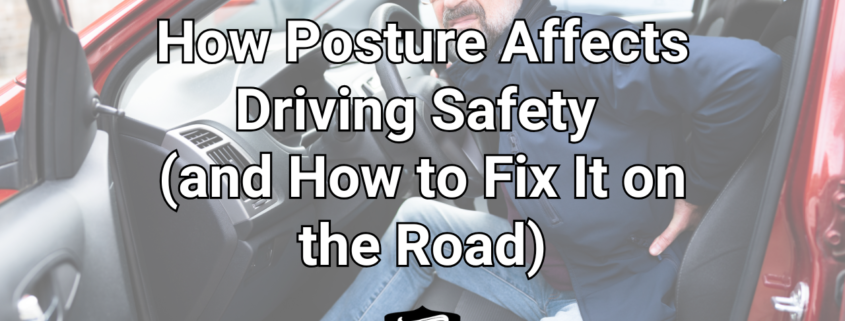How Posture Affects Driving Safety (and How to Fix It on the Road)
How Posture Affects Driving Safety (and How to Fix It on the Road)
For professional drivers, safety is everything. Most drivers think about safety in terms of speed, awareness, or road conditions. But here’s a factor many overlook: posture.
How you sit behind the wheel doesn’t just affect your comfort — it directly impacts your reaction time, fatigue, and overall driving safety.
Whether you’re hauling cross-country or navigating city routes, posture matters. The good news? A few small adjustments can make a huge difference in keeping you safe, alert, and pain-free.
The Connection Between Posture and Driving Safety
Driving posture isn’t just about comfort. It’s about how your body functions behind the wheel.
- Fatigue & Alertness → Slouching reduces lung capacity by up to 30%, limiting oxygen intake and making you feel drowsier faster (American Council on Exercise).
- Reaction Time → A hunched or twisted posture restricts blood flow and can slow down reflexes when quick movements are needed.
- Spinal Health → Long hours of poor posture increase risk of back pain, herniated discs, and sciatica — all of which affect focus and mobility.
- Vision & Focus → Poor posture can shift head and eye position, affecting visibility of mirrors and blind spots.
Translation: posture is a safety issue, not just a comfort issue.
The Most Common Truck Driver Posture Problems
After working with thousands of drivers, here’s what shows up most often in the cab:
- Slouching Shoulders – Hunched forward over the wheel.
- Forward Head Posture – “Turtle neck,” where the head juts forward.
- Rounded Lower Back – Sitting on the tailbone instead of the sit bones.
- One-Sided Leaning – Shifting weight to one hip or leaning on the armrest.
- Locked Knees – Sitting stiff with no lower-body movement for hours.
Each of these may feel minor at the moment, but over hundreds of miles, they add up to fatigue, pain, and slower reaction times.
The Ergonomics of a Safer Cab
Before we even talk stretches, let’s talk about seat setup. Just like pilots or athletes adjust their equipment, truckers need to fine-tune their cab ergonomics.
- Seat Height → Your hips should be level or slightly above your knees.
- Backrest Angle → Reclined about 100–110 degrees for support without slouching.
- Steering Wheel → Adjust so elbows are slightly bent; avoid reaching or locking arms.
- Mirror Check → Sit tall first, then adjust mirrors. This trains your body to maintain upright posture.
👉 Pro tip: If you adjust your mirrors while slouching, you’ll unconsciously keep slouching to see them.
Quick Fixes: 5 Simple On-the-Road Posture Resets
Here are easy posture practices you can do on breaks — or even at red lights.
1. Shoulder Blade Squeeze
Counteracts slouching and opens chest for better breathing.
- Sit tall.
- Squeeze shoulder blades together like you’re pinching a pencil.
- Hold for 3 seconds, release. Repeat 10 times.
2. Neck Rolls & Chin Tucks
Fixes forward head posture.
- Gently drop chin toward chest, roll head side to side.
- Then, sit tall and draw your chin straight back (like making a double chin).
- Hold 5 seconds, repeat 5–10 times.
3. Seated Pelvic Tilts
Resets lower back tension.
- Sit tall.
- Tilt pelvis forward (arch back slightly), then tilt backward (round back).
- Repeat slowly 10–15 times.
4. Seated Leg Extensions
Improves circulation, reduces stiffness.
- Extend one leg straight out, flex foot up and down.
- Alternate legs, 10 reps each.
5. 360° Breathing
Expands lungs, boosts alertness.
- Place one hand on the chest, one on the belly.
- Inhale deeply through the nose, expanding ribs and belly.
- Exhale slowly through your mouth.
- Repeat for 1–2 minutes.
👉 Research shows diaphragmatic breathing reduces stress and improves cognitive focus (National Library of Medicine).
The Business Case for Posture & Driver Wellness
Posture isn’t just a personal health issue — it’s a company safety issue.
- Accident Risk → Fatigue-related accidents account for up to 13% of truck crashes (FMCSA). Poor posture contributes to fatigue.
- Healthcare Costs → Back pain is one of the leading causes of missed work days across industries.
- Driver Retention → Companies that support wellness and comfort see higher driver satisfaction and retention rates.
For CDL schools and fleets, teaching posture as part of driver training is a proactive step toward safer roads and healthier drivers.
Final Thoughts: Posture as a Safety Tool
Every driver has a seatbelt. Every driver checks mirrors. But not every driver thinks about posture.
Yet posture is one of the most overlooked safety tools you already have. By sitting tall, breathing deeply, and taking a few minutes for on-the-road stretches, you protect not only your health, but also your alertness, focus, and safety on the road.
Remember: posture isn’t just about looking good. It’s about driving safe, staying strong, and making it home at the end of the day.
✨ Want more simple stretches for the road? Check out our Mother Trucker Yoga Jumpstart Programs for practical driver wellness you can do anywhere — no gym required.




Leave a Reply
Want to join the discussion?Feel free to contribute!